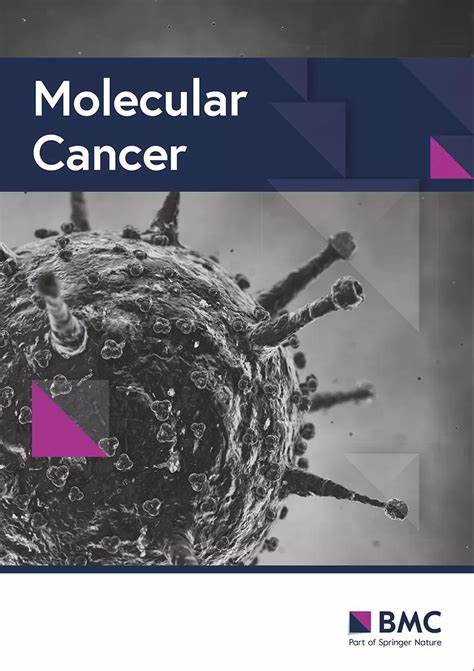在乳腺癌中,LMTK3调控EV生物发生和货物分选通过减少单核细胞浸润和驱动致瘤巨噬细胞极化来促进肿瘤生长。
IF 33.9
1区 医学
Q1 BIOCHEMISTRY & MOLECULAR BIOLOGY
引用次数: 0
摘要
狐猴尾激酶3 (LMTK3)促进细胞增殖、侵袭性和治疗耐药,其表达与包括乳腺癌在内的几种不同恶性肿瘤的低生存率相关。通过细胞外囊泡(EVs)的串扰是肿瘤免疫微环境中细胞通信的一种日益受到重视的机制,它有助于癌症进展的不同方面,并在塑造肿瘤命运中发挥关键作用。方法采用纳米粒子跟踪分析和透射电镜技术研究LMTK3对EV大小的影响,采用单粒子干涉技术研究LMTK3对EV亚群分布的影响。采用定量质谱法分析乳腺癌源性ev中lmtk3依赖的蛋白质组学变化。通过临床数据的生物信息学分析以及体外和基于细胞的实验来探索lmtk3依赖性EV蛋白货物对肿瘤免疫微环境的影响。为了阐明LMTK3影响内体运输和调节EV生物发生的机制,我们使用了多种方法,包括体外激酶测定,共聚焦和电子显微镜,以及体内皮下和原位乳腺癌小鼠模型。结果LMTK3增加了EV的平均大小,调节了免疫调节EV的蛋白质组,并改变了乳腺癌细胞释放EV的亚群分布。在机制上,我们提供的证据表明,LMTK3磷酸化Rab7,这是多泡体(MVB)运输的关键调节因子,从而减少MVBs与溶酶体的融合和随后的腔内囊泡降解,导致EV释放改变。此外,LMTK3导致电动汽车中磷酸丝氨酸转氨酶1 (PSAT1)的包装增加,导致这些电动汽车被吸收时单核细胞中磷酸甘油脱氢酶(PHGDH)的旁分泌上调。PSAT1和PHGDH在丝氨酸生物合成途径中发挥关键作用,丝氨酸生物合成途径与癌症进展和单核细胞行为调节密切相关。LMTK3 ev诱导单核细胞中PHGDH表达升高,可减少其对乳腺癌3D球体和体内乳腺癌小鼠模型的浸润。此外,这些浸润的单核细胞优先分化为促肿瘤的m2样巨噬细胞。另外的乳腺癌小鼠研究强调了lmtk3依赖性ev在观察到的免疫抑制巨噬细胞表型中的作用。最后,体外实验表明,LMTK3的药理抑制逆转了LMTK3过表达细胞衍生的ev介导的促肿瘤和免疫调节作用。总之,本研究提高了我们对EV生物发生机制的认识,并强调了LMTK3在乳腺TME中的新致癌作用,进一步支持其作为癌症治疗的靶点。本文章由计算机程序翻译,如有差异,请以英文原文为准。
LMTK3 regulation of EV biogenesis and cargo sorting promotes tumour growth by reducing monocyte infiltration and driving pro-tumourigenic macrophage polarisation in breast cancer.
BACKGROUND
Lemur Tail Kinase 3 (LMTK3) promotes cell proliferation, invasiveness and therapy resistance, and its expression correlates with poor survival in several different malignancies, including breast cancer. Crosstalk through extracellular vesicles (EVs) is an increasingly appreciated mechanism of cell communication within the tumour immune microenvironment, which contributes to different aspects of cancer progression and plays a pivotal role in shaping tumour fate.
METHODS
Nanoparticle tracking analysis and transmission electron microscopy were used to study the effects of LMTK3 on EV size, while single particle interferometry allowed us to examine LMTK3-dependent effects on the subpopulation distribution of EVs. Quantitative mass spectrometry was used to profile LMTK3-dependent proteomics changes in breast cancer-derived EVs. Bioinformatics analysis of clinical data along with in vitro and cell-based assays were implemented to explore the effects of LMTK3-dependent EV protein cargo on the tumour immune microenvironment. To elucidate the mechanism through which LMTK3 impacts endosomal trafficking and regulates EV biogenesis, we used a variety of approaches, including in vitro kinase assays, confocal and electron microscopy, as well as in vivo subcutaneous and orthotopic breast cancer mouse models.
RESULTS
Here, we report that LMTK3 increases the average size of EVs, modulates immunoregulatory EV proteomic cargo and alters the subpopulation distribution of EVs released by breast cancer cells. Mechanistically, we provide evidence that LMTK3 phosphorylates Rab7, a key regulator of multivesicular body (MVB) trafficking, thereby reducing the fusion of MVBs with lysosomes and subsequent degradation of intralumenal vesicles, resulting in altered EV release. Moreover, LMTK3 causes increased packaging of phosphoserine aminotransferase 1 (PSAT1) in EVs, leading to a paracrine upregulation of phosphoglycerate dehydrogenase (PHGDH) in monocytes when these EVs are taken up. PSAT1 and PHGDH play key roles in the serine biosynthesis pathway, which is closely linked to cancer progression and regulation of monocyte behaviour. LMTK3 EV-induced elevated PHGDH expression in monocytes reduces their infiltration into breast cancer 3D spheroids and in vivo breast cancer mouse models. Furthermore, these infiltrating monocytes preferentially differentiate into pro-tumourigenic M2-like macrophages. Additional breast cancer mouse studies highlight the contribution of LMTK3-dependent EVs in the observed immunosuppressive macrophage phenotype. Finally, in vitro experiments show that pharmacological inhibition of LMTK3 reverses the pro-tumourigenic and immunomodulatory effects mediated by EVs derived from LMTK3 overexpressing cells.
CONCLUSION
Overall, this study advances our knowledge on the mechanisms of EV biogenesis and highlights a novel oncogenic role of LMTK3 in the breast TME, further supporting it as a target for cancer therapy.
求助全文
通过发布文献求助,成功后即可免费获取论文全文。
去求助
来源期刊

Molecular Cancer
医学-生化与分子生物学
CiteScore
54.90
自引率
2.70%
发文量
224
审稿时长
2 months
期刊介绍:
Molecular Cancer is a platform that encourages the exchange of ideas and discoveries in the field of cancer research, particularly focusing on the molecular aspects. Our goal is to facilitate discussions and provide insights into various areas of cancer and related biomedical science. We welcome articles from basic, translational, and clinical research that contribute to the advancement of understanding, prevention, diagnosis, and treatment of cancer.
The scope of topics covered in Molecular Cancer is diverse and inclusive. These include, but are not limited to, cell and tumor biology, angiogenesis, utilizing animal models, understanding metastasis, exploring cancer antigens and the immune response, investigating cellular signaling and molecular biology, examining epidemiology, genetic and molecular profiling of cancer, identifying molecular targets, studying cancer stem cells, exploring DNA damage and repair mechanisms, analyzing cell cycle regulation, investigating apoptosis, exploring molecular virology, and evaluating vaccine and antibody-based cancer therapies.
Molecular Cancer serves as an important platform for sharing exciting discoveries in cancer-related research. It offers an unparalleled opportunity to communicate information to both specialists and the general public. The online presence of Molecular Cancer enables immediate publication of accepted articles and facilitates the presentation of large datasets and supplementary information. This ensures that new research is efficiently and rapidly disseminated to the scientific community.
 求助内容:
求助内容: 应助结果提醒方式:
应助结果提醒方式:


